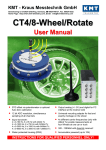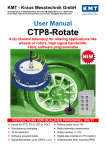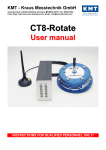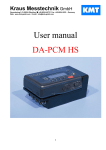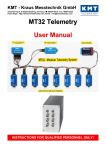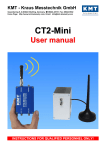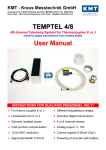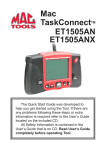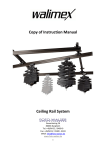Download - KMT Telemetry
Transcript
KMT - Kraus Messtechnik GmbH Gewerbering 9, D-83624 Otterfing, Germany, 08024-48737, Fax. 08024-5532 Home Page: http://www.kmt-telemetry.com, Email: [email protected] KMT-CLS Steering Effort Sensor for Automobiles and Trucks User – Manual INSTRUCTIONS FOR QUALIFIED PERSONNEL ONLY! Standard SET with blank adapters AC/DC Adapter CSL Decoder with analog and CAN output CSL torque sensor Setup software CAN Blank adapter for steering wheel Blank adapter for steering column CSL angle encoder Bank adapters for self-made! (incl. in SET) Blank adapter for steering column adapter for steering wheel Customize adapters for steering column and steering wheel on request!! adapter for steering column adapter for steering wheel example example 1 Exclusion of Liability KMT Kraus Messtechnik GmbH will not be liable for damages resulting from misuse or inappropriate treatment of the CLS, no matter whether such defects occur on the KMTCLS itself or as consequential damages on other items. Consideration of the following is required in particular: The KMT-CLS has no MOT approval, i.e. it is not approved for use in public areas. Mounting and dismounting of the airbag should be performed by properly skilled staff only. In case of any kind of overstress (car crash, activation of the airbag, etc.) the KMT-CLS should no longer be used. Road safety is in the sole responsibility of the user. Assembly and dismantling of the sensor should be performed by properly skilled staff only. Inappropriate treatment, misuse or damage of the KMT-CLS leads to immediate expiration of warranty and all guarantee rights granted by KMT Kraus Messtechnik GmbH. Manual - Steering Effort Sensor CLS 2 Introduction The KMT-CLS steering effort sensor is a precise telemetry system, which can be used in passenger cars and trucks. It is designed to evaluate the steering torque and steering angle while driving. Due to years of experience in the field engineers have been able to use all the advantages of modern electronics to build a small transducer, which can be installed between the steering column and the original steering wheel. Therefore it is nearly unnoticed by the driver and the dynamic values of a standard steering wheel are preserved. A particular feature of this transducer is the ability to feed all electrical signals of the steering wheel through this device, so the functionality of the airbag, LIN-bus and others are preserved. To guarantee a torque free operation without interferences the transducer has an inbuilt telemetry system. The compact control unit can be easily integrated inside the passenger cabin. With several adapters to the steering column it is easy to use the transducer in different types and models of cars without complex mounting procedures. Version 2012-10 3 Technical Data are subject to change without notice! 3 Technical Data 3.1 Transducer Unit General Outer diameter: Height: Operational Height: Weight: Operating temperature: Power supply: Torque Transducer Sensor type: Measure range: Mechanic capacity: approx. 100 mm approx. 65 mm without adapters approx. 96 mm depending on adapters and mounting 1.4 kg -20°C...80°C powered by control unit Torque direction: Accuracy: Temperature drift: Bandwidth: Test shunt signal: temperature compensated strain gauge ±100 Nm or ±200 Nm (determined by order) ±350 Nm, beyond this range steering is guaranteed by mechanical blocking positive torque means clockwise direction 0.2% FS max 0.004% FS / K 0 ... 800 Hz approx. 80Nm for 10 secs after power on Angle Encoder Sensor type: Angle resolution: incremental magnetic encoder 0.04° (8800 pulses/360°) 3.2 Control and Receiver Unit General Dimensions: Weight: Operating temperature: Power supply: CAN-Bus Interface Electric type: Configuration: Baud rate: Identifier: Message configuration Refresh rate: Zero adjustment for torque and angle: Torque range: Torque resolution: Version 2012-10 approx. 80mm x 105mm x 185mm 1.15 kg -20°C ... 80°C 9 ... 36 VDC ISO/DIN11898 with galvanic isolation via CAN using CCP-Protocol, the serial number is used for identification 10kBaud ... 1 MBaud programmable by software 11bit or 29bit programmable completely programmable max. 5000 Hz, can be divided by factor with software push-button on the front panel ±100 Nm or ±200 Nm, depending on type 16 bit (0.003 Nm or 0.006 Nm) 4 Technical Data are subject to change without notice! Angle range: Angle resolution: ±1340° 16 bit : 0.04° (8800 digits/360°) Rotational velocity range: Rotational velocity resolution: ±1000°/sec 16 bit Analog Outputs Voltage range: Analog offset trim: Bandwidth: ±10 V with potentiometer on the front panel 0 ... 800 Hz Torque signal range: Torque signal resolution: ±100 Nm or ±200 Nm, depending on type 12 bit (0.049 Nm or 0.098 Nm, depending on type) Angle signal range: Angle signal resolution: ±1000° (= ±10 V) 0.65° Frequency Output for Torque Signal Type: 5 V TTL square wave Frequency range: 10000 Hz ±5000 Hz 5000 Hz: = -100 Nm or –200 Nm 10000 Hz: = 0 Nm 15000 Hz: = +100 Nm or +200 Nm Digital Display Torque display: Torque display resolution: ±100 Nm or ±200 Nm, direct reading 0.1 Nm Angle display: Angle display resolution: ±1000° direct reading 1° Version 2012-10 5 Technical Data are subject to change without notice! 4 Installation The CLS-transducer system consists of the angle encoder with angle restraint, steering wheel adapter, torque sensor and steering column adapter. The two adapters are vehiclespecific, blank adaptors can be supplied for self machining by the customer. From left: Encoder, steering wheel adapter, screw, CLS-sensor, steering column adapter 4.1 Assembly steps: 1. Dismantle standard steering wheel and prepare the steering wheel wiring. IMPORTANT: Work on the airbag system should only be carried out by skilled personnel. 2. Insert the steering column adapter on the steering column. 3. Mount the CLS-sensor to the column and tighten it with the central screw. 4. Attach the steering wheel adapter on the CLS-sensor and fix it with 8 screws. 5. Place the encoder over the adapter and push it on the sensor, then fix it with grub screws. IMPORTANT: Note arrows on the encoder and KMT-CLS sensor must be lined up when mounting. 6. Fix the angle restraint from the Encoder to a non rotating part of the vehicle. 7. Mount the standard steering wheel on the adapter and screw it according to the car manufacturer’s instructions. Version 2012-10 6 Technical Data are subject to change without notice! 4.2 Steering wheel wiring The original steering wheel must be dismounted and its cable connections must be unplugged. The best way to reinstall the wiring of the steering wheel is to solder cable adapters to the transducer. Soldering pads on the upper side soldering pads on the bottom side To maintain complete functionality of the steering wheel it is necessary to reconnect all the signals for power, LIN-bus and airbag. Therefore the sensor has 6 identical soldering pads, which can be used in either way. Each line has a continuous current rating of 4 Amps. Pay attention to ensure identical pinning on the top and bottom side. 4.3 Assembly of the steering column adapter Insert the vehicle-specific steering column adapter over the toothing of the steering column. The assembly may vary slightly, depending on the car manufacturer. Assembly of the steering column adapter Version 2012-10 7 Technical Data are subject to change without notice! 4.4 Assembly of the sensor Now plug the CLS-Sensor on the adapter of the steering column. The angular position is arbitrary. Fix the sensor with the central screw to the steering column. The car manufacturer’s instruction should be followed, especially regarding the fastening torque and screw locking. Assembly of the sensor 4.5 Assembly of the steering wheel adapter Afterwards the steering wheel adapter will be mounted on the sensor body and screwed with eight M4x14 12.9 cheese head screws with a fastening torque of 3Nm. For disassembling there are 4 threads for the ejection screws. Open the 8 screws, than eject the adapter with the 4 ejection screws. Assembly of the steering wheel adapter Version 2012-10 8 Technical Data are subject to change without notice! 4.6 Assembly of the encoder Place the encoder over the adapter and push it on the sensor by taking note of the arrow which indicates the angular position. Then fix it with four M2.5x4 grub screws. Assembly of the encoder 4.7 Assembly of the restrain Fix the restraint from the Encoder to a fixed part of the vehicle. This connection should be very firm to achieve the correct angular accuracy. Assembly of the steering wheel Steering wheel mounted 4.8 Assembly of the steering wheel Mount the standard steering wheel on the KMT-CLS transducer assembly. This operation should be carried out according to the car manufacturer’s instructions. IMPORTANT: Work on the airbag should only be performed by skilled personnel. Version 2012-10 9 Technical Data are subject to change without notice! 5 Connections and Startup The cable of the transducer must be connected to the socket on the rear panel of the control unit. To power the complete system there are two 4mm banana sockets on the rear panel. They must be connected to the on-board electrical system or another suitable power supply. The power supply included in the package can be used for testing in laboratory or in test rigs. After power up of the control unit, an automatic shunt in the sensor will be activated. It produces a test signal of about 80 Nm, which holds for about 10 seconds. This is a simple functional test of the torque channel. With the push-button ‘CAL‘ on the front panel the user can release an auto zero procedure for the torque and the angle channel Attention: Only active with CAN interface! For the Analog Offset please use the potentiometer! The complete configuration of the CAN interface is done with the software NetModconfig, which is included in the package. Version 2012-10 10 Technical Data are subject to change without notice! 6 Connector for CAN Bus CAN_LOW Ground 1 2 3 4 5 6 7 8 9 CAN_HIGH D-Sub 9-pins female connector at the rear panel Attention ! If the CAN output is connected to an end of a CAN line, it must be terminated by an external 120 ohms resistor, located between CAN-High and CANLow line. Version 2012-10 11 Technical Data are subject to change without notice!













